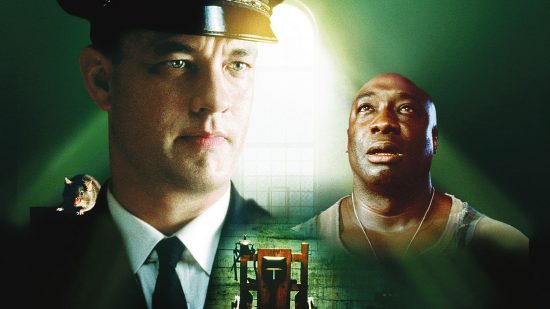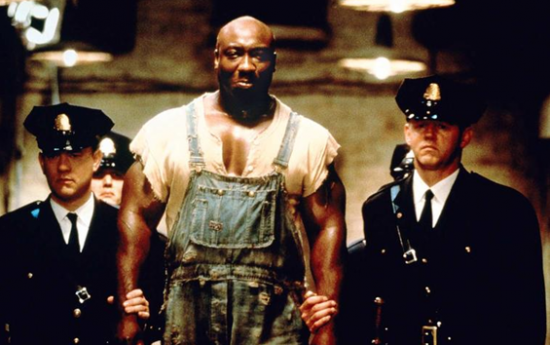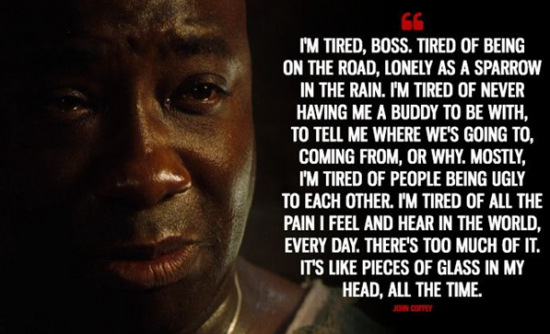The Death Penalty Moral Dilemma in The Green Mile
The Green Mile is known as a real masterpiece of Stephen King and one of his most meaningful novels. It is a story about prison officers and prisoners in a death row known as the “Green Mile.” Probably, you know this story even better because of its great filming directed by Frank Darabont and starring Tom Hanks. This movie includes many messages, but the question of capital punishment and its morality is often viewed as the most important topic of The Green Mile. Both the film and the book present the death penalty moral dilemma and make the audience doubt the relevance of such a punishment.
- Killing the Innocent
In The Green Mile, you witness a situation in which an innocent person is condemned to capital punishment. One of the main characters of this crime drama, John Coffey, has to die for the murder of two white girls. In some time, the viewer starts to understand that Coffey may be innocent. At the end of the film, this character kills the real murder of the two girls, and a prison officer Paul Edgecomb understands that he has to condemn an innocent person to death. In one of the story’s most dramatic moments, Coffey tells Paul that he does not want to live in such a cruel world, filled with murderers and villains. He accepts his fate and dies on an electric chair.
- Loss of a Unique Talent
Traditionally for films based on the novels of Stephen King, The Green Mile includes the elements of supernatural. John Coffey is a mysterious person with unique talents. He can revive the dead and cure the most difficult health conditions. As a viewer of the film, you may only imagine how many people can be saved by this person. Unfortunately, the talents of the character remain unknown to the majority as he is doomed to waste his life in prison. The real tragedy of the situation is that a generous person who can make the world a better place has to die for the crime he did not even commit. Such a situation can repeat in many other situations with the death penalty because sentenced people may still want to bring something good to this world.
- Leaving Crimes Unsolved
If you review various essay examples on the topics of The Green Mile and the death penalty, you will, most probably, notice that they primarily focus on the tragic death of John Coffey. At the same time, capital punishment is questionable not only because of the harm caused to an innocent person but also because it may leave crimes unsolved. Even if it goes about a free essay on capital punishment, this text should take into account the fact that there were situations in which the truth about a crime was revealed long after the court’s final decision. Police officers just understood that a wrong person was killed, while a real criminal had been living all that time like an ordinary citizen.
- Security Officers Can Be Real Villains
If you have watched The Green Mile, you, most probably, know that Percy Wetmore is the most disgusting character in the narrative. This security officer is a real sadist who gets satisfaction in tormenting poor prisoners. He is hated by his colleagues, but he is also a nephew of Louisiana’s First Lady. This point makes the viewers hate him even more because Wetmore can consider himself untouchable. The examples of such persons show that, sometimes, people in charge of prisoners are eviler than the prisoners. The Green Mile shows us that there are situations when security officers, who get satisfaction in prisoners’ agony on an electric chair, are the real villains that deserve the severest punishment.
- Physical Suffering
Lots of essay samples dedicated to the topic of a capital punishment state that it can make people feel inhumane suffering. Surely, law enforcement officers may say that accused criminals do not feel any pain because their demise is very quick. The example of Eduard Delacroix from The Green Mile, who had a gruesome death on the electric chair, shows that the death penalty is not always as human as its proponents want to present it. After watching the scene of this character’s death, a viewer starts to understand that capital punishment is a barbaric ritual that makes people, who may even be innocent, feel terrible pain.
- Mental Suffering
Capital punishment is also inhumane because of the associated mental suffering of condemned people. The Green Mile conveys the atmosphere of helplessness and despair experienced by people who understand that they are going to die soon. Awaiting a capital punishment can be even worse than the very moment of death. As a viewer, you can easily recognize it from different images of broken prisoners who are condemned to death on the electric chair.
The Green Mile is a notable masterpiece of cinematography addresses the moral dilemma of the death penalty. As a viewer, you are forced to understand that capital punishment can lead to the death of an innocent person, kill someone who can still bring something good into our world, or leave the crime unsolved. Also, this film shows that criminals are not always the evilest persons and that the death penalty makes them feel both physical and mental suffering. The Green Mile is a powerful manifest that emphasizes the barbaric essence of the death penalty. At the same time, it is still up to you which conclusions to make on the film, which is one of its most attractive features.












